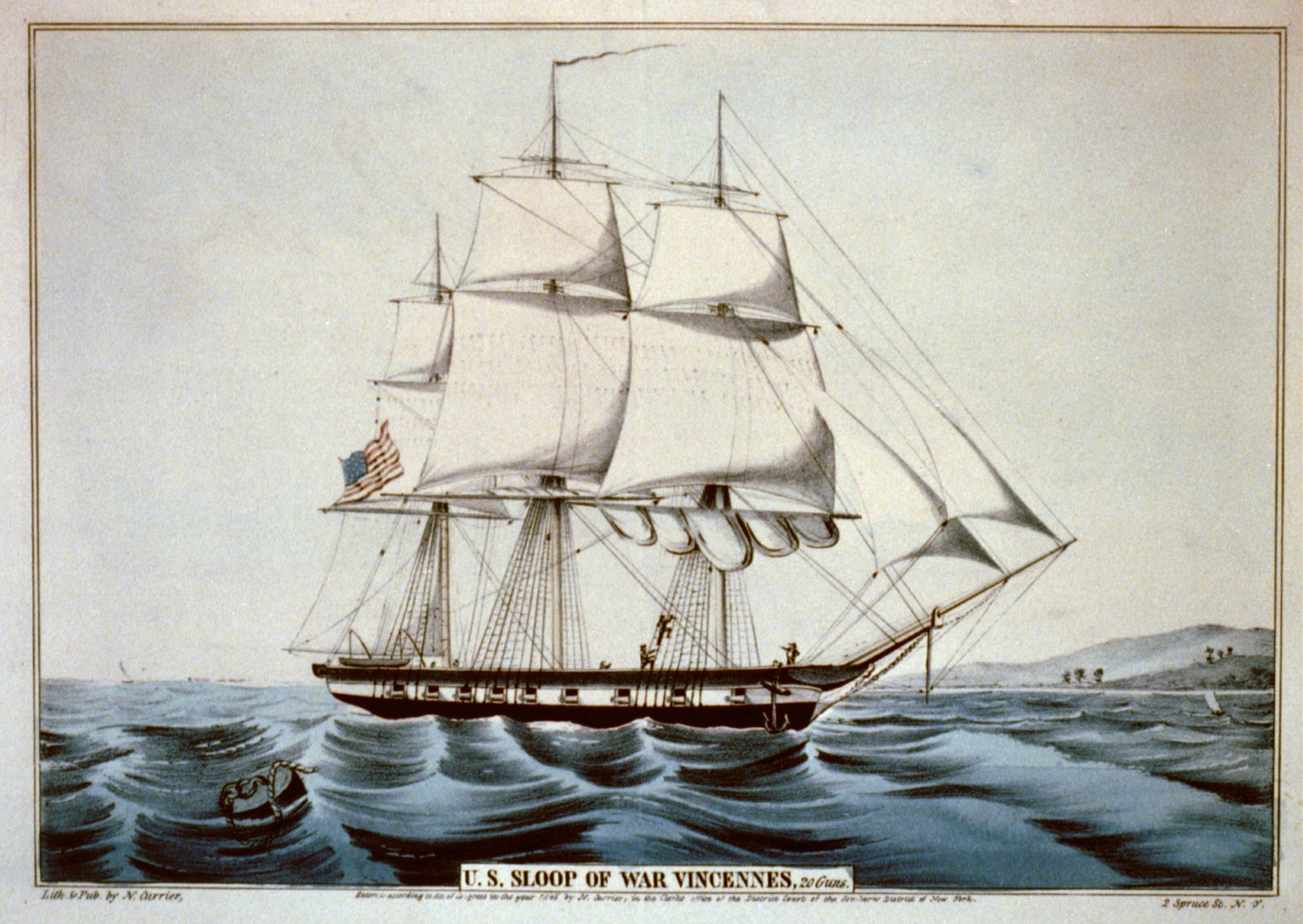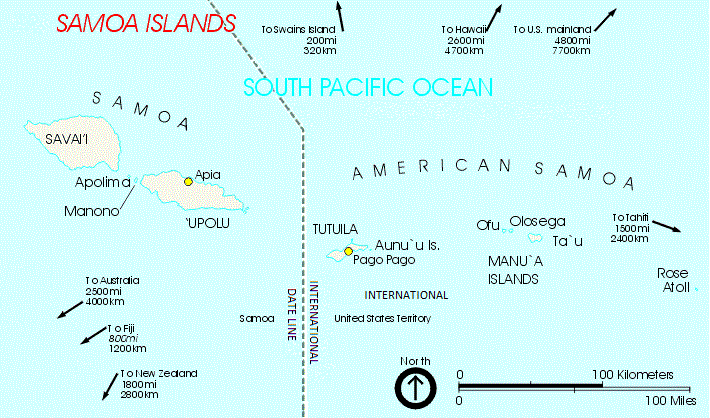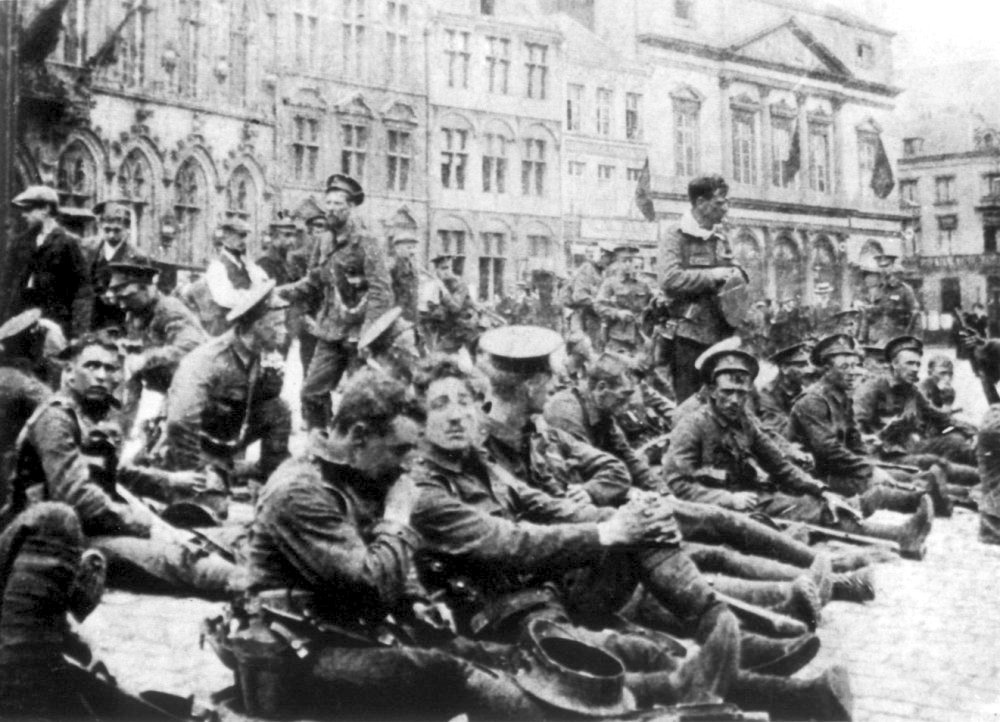|
Fagasā, American Samoa
Fagasā is a village in the Eastern District of Tutuila Island in American Samoa. The village lies by Fagasa Bay, on the north shore of the island. Its name is Samoan and translates to "Forbidden Bay." The village borders the Tutuila-section of National Park of American Samoa. Fagasa has two sub-villages: Fagatele (Big Bay) on the west side, where Leatele School is located, and Fagalea on the east side, by the chapel of the Congregational Christian Church in American Samoa (CCCAS). Forbidden Bay has been described as one of the most beautiful bays in the South Pacific Ocean. It can be reached by boat or from Fagasā by foot. Fagasā Pass, near the Vaipito Valley border with Pago Pago, serves as the main access point for trails to both Mount ʻAlava and Mount Matafao. The Mount ʻAlava trail begins on the north side of Route 5, while the Mount Matafao trail starts on the south side, directly across from the Mount Alava trailhead. A porpoise sanctuary is located in Fagasa ... [...More Info...] [...Related Items...] OR: [Wikipedia] [Google] [Baidu] |
Samoan Language
Samoan ( or , ) is a Polynesian languages, Polynesian language spoken by Samoans of the Samoan Islands. Administratively, the islands are split between the sovereign country of Samoa and the Unincorporated territories of the United States, United States territory of American Samoa. It is an official language, alongside English language, English, in both jurisdictions. It is widely spoken across the Pacific region, heavily so in New Zealand and in Australia and the United States. Among the Polynesian languages, Samoan is the most widely spoken by number of native speakers. Samoan is spoken by approximately 260,000 people in the archipelago and with many Samoans living in diaspora in a number of countries, the total number of speakers worldwide was estimated at 510,000 in 2015. It is the third-most widely spoken language in New Zealand, where 2.2% of the population, 101,900 people, were able to speak it as of 2018. The language is notable for the phonology, phonological differenc ... [...More Info...] [...Related Items...] OR: [Wikipedia] [Google] [Baidu] |
Bess Press
Bess Press is an American publisher, based in Hawaii, that issues various books on Hawaiian and Pacific history and culture. It was founded in 1979 by Benjamin "Buddy" Bess, who came to Hawaii in 1976 from New York New York most commonly refers to: * New York (state), a state in the northeastern United States * New York City, the most populous city in the United States, located in the state of New York New York may also refer to: Places United Kingdom * .... Bess bought the rights to two out-of-print textbooks on Hawaiian language, '' Hawaii: The Aloha State'' and '' Hawaii: Our Island State'' that local schools asked about when he was a sales representative for mainland publishers. He reprinted both volumes for $15,000, and pre-sold the copies, thus making a profit. References External linksOfficial site Book publishing companies based in Hawaii Publishing companies established in 1979 1979 establishments in Hawaii Hawaiian studies {{US-publish-company-st ... [...More Info...] [...Related Items...] OR: [Wikipedia] [Google] [Baidu] |
Upolu Island
Upolu is an island in Samoa, formed by a massive basaltic shield volcano which rises from the seafloor of the western Pacific Ocean. The island is long and in area, making it the second largest of the Samoan Islands by area. With approximately 145,000 inhabitants, it is by far the most populous of the Samoan Islands. Upolu is situated to the southeast of Savai'i, the "big island". Apia, the capital, is in the middle of the north coast, and Faleolo International Airport at the western end of the island. The island has not had any historically recorded eruptions, although there is evidence of three lava flows, dating back only to between a few hundred and a few thousand years ago. In the Samoan branch of Polynesian mythology, Upolu was the first woman on the island. James Michener based his character Bloody Mary in ''Tales of the South Pacific'' (later a major character in the Rodgers and Hammerstein musical, ''South Pacific'') on the owner of Aggie Grey's Hotel on the south e ... [...More Info...] [...Related Items...] OR: [Wikipedia] [Google] [Baidu] |
Pago Pago
Pago Pago ( or ; Samoan language, Samoan: )Harris, Ann G. and Esther Tuttle (2004). ''Geology of National Parks''. Kendall Hunt. Page 604. . is the capital of American Samoa. It is in Maoputasi County, American Samoa, Maoputasi County on Tutuila, the main island of American Samoa. Pago Pago is home to one of the deepest natural harbors in the South Pacific Ocean, sheltered from wind and rough seas, and strategically located.United States Central Intelligence Agency (2016). ''The World Factbook 2016–17''. Government Printing Office. Page 19. .Grabowski, John F. (1992). ''U.S. Territories and Possessions (State Report Series)''. Chelsea House Pub. .Kristen, Katherine (1999). ''Pacific Islands (Portrait of America)''. San Val. . The harbor is also one of the best protected in the South Pacific,Leonard, Barry (2009). ''Minimum Wage in American Samoa 2007: Economic Report''. Diane Publishing. . which gives American Samoa a natural advantage because it makes landing fish for processi ... [...More Info...] [...Related Items...] OR: [Wikipedia] [Google] [Baidu] |
Archibald Murray
General Sir Archibald James Murray, (23 April 1860 – 21 January 1945) was a British Army officer who served in the Second Boer War and the First World War. He was chief of staff to the British Expeditionary Force (BEF) in August 1914 but appears to have suffered a physical breakdown in the retreat from Mons, and was required to step down from that position in January 1915. After serving as Deputy Chief of the Imperial General Staff for much of 1915, he was briefly Chief of the Imperial General Staff from September to December 1915. He was subsequently Commander-in-Chief of the Egyptian Expeditionary Force from January 1916 to June 1917, in which role he laid the military foundation for the defeat and destruction of the Ottoman Empire in the Arabian Peninsula and the Levant. Military career Born the son of Charles Murray and his wife Anne Graves, and educated at Cheltenham College and the Royal Military College, Sandhurst, Archibald James Murray was commissioned as a ... [...More Info...] [...Related Items...] OR: [Wikipedia] [Google] [Baidu] |
London Missionary Society
The London Missionary Society was an interdenominational evangelical missionary society formed in England in 1795 at the instigation of Welsh Congregationalist minister Edward Williams. It was largely Reformed tradition, Reformed in outlook, with Congregational church, Congregational missions in Oceania, Africa, and the Americas, although there were also Presbyterians (notable for their work in China), Methodists, Baptists, and various other Protestants involved. It now forms part of the Council for World Mission. Origins In 1793, Edward Williams (minister), Edward Williams, then minister at Carr's Lane, Birmingham, wrote a letter to the churches of the Midlands, expressing the need for interdenominational world evangelization and foreign missions.Wadsworth KW, ''Yorkshire United Independent College -Two Hundred Years of Training for Christian Ministry by the Congregational Churches of Yorkshire'' Independent Press, London, 1954 It was effective and Williams began to play an acti ... [...More Info...] [...Related Items...] OR: [Wikipedia] [Google] [Baidu] |
French Ship Astrolabe (1781)
''Astrolabe'' was a converted En flûte, flûte of the French Navy, famous for her travels with Jean-François de Galaup, comte de Lapérouse. She was built in 1781 at Le Havre as the flûte ''Autruche'' for the French Navy. In May 1785 she and her sister ship French ship Boussole (1782), ''Boussole'' (previously ''Portefaix'') were renamed, rerated as frigates, and fitted for round-the-world scientific exploration. The two ships departed from Brest, France, Brest on 1 August 1785, ''Boussole'' commanded by Lapérouse and ''Astrolabe'' under Paul Antoine Fleuriot de Langle. Disappearance The expedition vanished mysteriously in 1788 after leaving Botany Bay on 10 March 1788. Captain Peter Dillon in solved the mystery in 1827 when he found remnants of both ships at Vanikoro Island in the Solomon Islands. Local inhabitants reported that the ships had been wrecked in a storm. Survivors from one ship had been massacred, while survivors from the other had constructed their own small ... [...More Info...] [...Related Items...] OR: [Wikipedia] [Google] [Baidu] |
Aʻasu, American Samoa
Aasu or Āsu is a village on the north coast of Tutuila Island, American Samoa. It is located to the west of Fagasā, American Samoa, Fagasa and northwest of Pago Pago. It is one of multiple villages involved in an archaeological survey of the island. Old Aasu lies on Massacre Bay (American Samoa), Massacre Bay and can be reached from a hiking trail in Aasufou (new Aasu). Aasu has no road outlets, and can only be reached by hiking trails or by sea. It is a near-abandoned village which is home to just a few families. It is possible to camp in the village before returning to Aasufou. Aasu might be most famous for a battle which took place on December 11, 1787, where twelve Europeans and 39 Samoans were killed. A monument erected by the French can be found in Aasutuai (old Aasu). In 1979, a road was constructed connecting the Tafuna, American Samoa, Tafuna Plain on the southern coast to the mountainous region above A‘asu. During the same year, a dirt road was extended down to A‘a ... [...More Info...] [...Related Items...] OR: [Wikipedia] [Google] [Baidu] |
Paul Antoine Fleuriot De Langle
Paul Antoine Fleuriot de Langle (1 August 1744, château de Kerlouët at Quemper-Guézennec, Côtes-d'Armor – 11 December 1787, Maouna, Samoa) was a French vicomte, académicien de marine, naval commander and explorer. He was second in command of the La Pérouse expedition, which departed France on 1 August 1785 and was eventually lost in the Pacific. Fleuriot de Langle died in an encounter with natives in what is now American Samoa before the expedition was lost; his remains were returned to France, and were buried in the choir of the church of Saint-Louis at Brest. Biography In 1771, aged only 27, Fleuriot de Langle was admitted as a member of the Académie de Marine. He was promoted to Lieutenant in 1778. Fleuriot de Langle took part in the American Revolutionary War. In April 1781, Fleuriot de Langle was given command of the 32-gun frigate ''Résolue''. From March 1782, he commanded the 50-gun ''Experiment'', and then commanded the frigate ''Astrée'' in the Hu ... [...More Info...] [...Related Items...] OR: [Wikipedia] [Google] [Baidu] |
French Ship Boussole (1782)
''Boussole'' was a former fluyt, flûte of the French Navy, famous for its exploration of the Pacific under Jean-François de Galaup, comte de Lapérouse. She was built in 1781–82 at Bayonne as the flûte ''Portfaix'' for the French Navy. In May 1785 she and her sister ship French ship Astrolabe (1781), ''Astrolabe'' (previously the ''Autruche'') were renamed, rerated as frigates, and fitted for round-the-world scientific exploration. It departed Brest, France, Brest on 1 August 1785 under Lapérouse, accompanied by the ''Astrolabe'' under Paul Antoine Fleuriot de Langle. The expedition vanished mysteriously in 1788 after leaving Botany Bay on 10 March 1788. Captain Peter Dillon in solved the fate of the expedition when he found remnants of both vessels at Vanikoro Island in the Solomon Islands. Local inhabitants reported that a storm had wrecked both ships. Survivors from one ship had been massacred while survivors from the other ship had constructed their own small boat and ... [...More Info...] [...Related Items...] OR: [Wikipedia] [Google] [Baidu] |
King Louis XVI
Louis XVI (Louis-Auguste; ; 23 August 1754 – 21 January 1793) was the last king of France before the fall of the monarchy during the French Revolution. The son of Louis, Dauphin of France (son and heir-apparent of King Louis XV), and Maria Josepha of Saxony, Louis became the new Dauphin when his father died in 1765. In 1770, he married Marie Antoinette. He became King of France and Navarre on his grandfather's death on 10 May 1774, and reigned until the abolition of the monarchy on 21 September 1792. From 1791 onwards, he used the style of king of the French. The first part of Louis XVI's reign was marked by attempts to reform the French government in accordance with Enlightenment ideas. These included efforts to increase tolerance toward non-Catholics as well as abolishing the death penalty for deserters. The French nobility reacted to the proposed reforms with hostility, and successfully opposed their implementation. Louis implemented deregulation of the grain marke ... [...More Info...] [...Related Items...] OR: [Wikipedia] [Google] [Baidu] |





